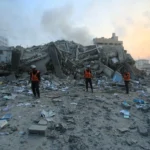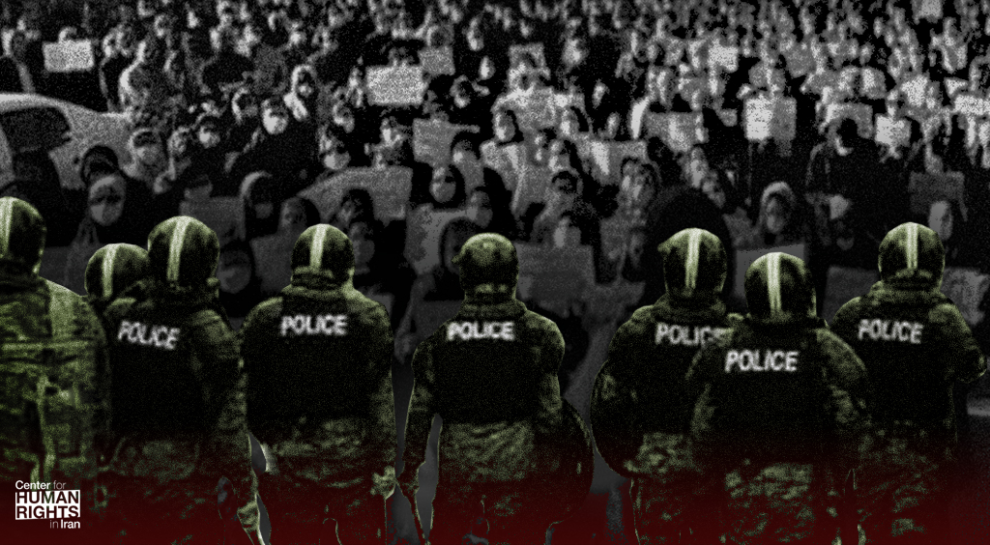Iranian security forces used excessive force on protesters commemorating the anniversary of the brutal “Bloody Friday” government crackdown on large anti-government demonstrations in 2022, Human Rights Watch said today.
Security forces fired “birdshot” shotgun pellets, rubber bullets, and tear gas and beat and otherwise assaulted protesters on September 29, 2023, and again on October 20. The United Nations Independent Fact-Finding Mission on Iran should investigate the pattern of excessive force and arbitrary arrests at protests, particularly in areas with large ethnic and religious minorities such as the city of Zahedan in Sistan and Baluchistan province.
“Iranian authorities are as committed as ever to brutally crushing protests of their own people who demand fundamental change,” said Tara Sepehri Far, senior Iran researcher at Human Rights Watch. “Security forces also appear to deploy excessive and lethal force even more quickly in cities like Zahedan that have large ethnic and religious minority groups.”
Human Rights Watch interviewed three witnesses to the September 29 protest and one on October 20 and verified and analyzed 14 videos posted to Telegram between September 29 and October 5. These show that on September 29, security forces were armed with shotguns and machine guns and deployed tear gas against protesters, beating them with batons outside the Maki Mosque in the city center of Zahedan. Witnesses told Human Rights Watch that security forces shot at protesters with birdshot and paintball pellets to their upper bodies, beat them with batons, and arrested large numbers of protesters, including children.
Human Rights Watch also verified photos shared by human rights activists that show tear gas and shotgun cartridges marked as originating from Maham Manufacturing. Munitions from this company were commonly used during the crackdown on the mass protests in 2022.
The recent protests commemorated the deadly repression on September 30, 2022, in Zahedan, the predominantly Baluchi capital of Sistan and Baluchistan, one of the most economically marginalized areas of the country. On this day, known as “Bloody Friday,” Iranian security forces employed unlawful lethal force, resulting in the deaths and injuries of several dozen protesters, the largest number of casualties on any day during the 2022 protests. Thode who were killed included people leaving the Friday prayer at the Grand Mosalla Prayer Hall.
Witnesses said that in the days leading up to the anniversary, security forces in Zahedan strategically positioned themselves on streets and intersections. Security forces arbitrarily stopped people heading toward the mosque for Friday prayers, checking their identification papers and inspecting their mobile phones to find any videos or photos related to the previous protests. According to Haalvsh, a human rights group that reports on violations in and Baluchistan, security forces detained numerous individuals, including at least 32 children.
Two witnesses who spoke to Human Rights Watch and Haalvsh reported that after Friday prayers ended on September 29, protesters chanted against the government while leaving Maki Mosque. The witnesses said that security forces, including Revolutionary Guards, police, and Basij paramilitary forces then attacked protesters without warning on Khayyam Street, using tear gas, birdshot, and paintball pellets.
“After the prayers, the security forces attacked people, they shot a lot of tear gas,” a witness said. “I heard kids were shot so I went to help them. My eyes were burning from all the tear gas, and I could see kids as young as elementary students were shot. It reminded me of Bloody Friday again. It was just the same, we couldn’t breathe, and our noses were burning. We couldn’t even see when and from where they were attacking us.”
Before losing consciousness from being hit in the back, he said, he saw 23 people being injured, mostly from birdshot and paintball pellets to their upper bodies. He said that he saw at least four people shot in their heads and faces, including their eyes, and that four of those injured were children.
According to Haalvsh, between September 29 and October 1, the authorities arrested at least 216 people in the cities of Zahedan, Khaash, Mirjaveh, and Chabahar in Sistan and Baluchistan. Security forces beat many of those arrested, Haalvsh found.
A woman from Zahedan said, “I witnessed an elderly man who wasn’t even participating in the protest and was simply leaving the mosque after the prayers. He was attacked violently by security forces. They beat him with batons and dragged him on the ground so forcefully that his clothes were torn apart. After, they arrested him and took him away on a motorcycle.”
After authorities violently cracked down on protests between September 29 and October 1, Haalvsh said that military and security forces had blocked off all streets and alleys surrounding the Maki Mosque on October 20. Haalvsh reported that security forces severely beat protesters with batons, reportedly arresting hundreds of people, including many older people and children, and taking them to detention centers using buses that had been prepared in advance.
Another woman said that on October 20, she witnessed arrests of at least 20 people: “I observed through the window that security forces arrested three children in the street adjacent to our house. This street is commonly used by people after prayers, and most of the confrontations occured in this part of the neighborhood. I was unable to record the arrests as they became aware that some individuals were watching from the windows.”
She said, “The security forces entered the buildings one by one in an attempt to identify the person recording. They even claimed that someone had thrown a stone from above, which was a lie … They had come with this excuse and were searching all the apartments. They also arrested one of our neighbors and severely beat another to the point of death.”
A relative of an 18-year-old said that officers using batons brutally arrested the 18-year-old and his friends, detained them for seven days, then moved them to a prison, where he is still being held. During that time, they were not given adequate food and scavenged for food in the trash.
On October 24, Amnesty International reported that on October 20, hundreds of people, among them dozens of children as young as 10, were forcefully apprehended, and that a significant number remain unaccounted for. Detainees, both children and adults, have experienced torture and other abuse, including severe beatings and injuries from close-range paintball shots. According to Haalvsh, on September 29, authorities shot Alireza Rigi, a 16-year-old boy with a physical disability, in the head with birdshot before beating and arresting him. He was then detained under a one-month temporary detention order. His brother, Erfan Rigi, was shot dead on Bloody Friday. Authorities turned over Erfan’s body to his family after a four-day delay, pressuring them to discreetly bury him, Haalvsh reported. Authorities also arrested Erfan’s father, who later received a five-year suspended sentence and was fired from his job.
Iranian authorities have routinely slowed down, restricted, or shut down internet access during widespread protests, including in Sistan and Baluchistan, as the protesters in Zahedan have gathered around the Maki Mosque frequently after Friday prayers over the past year. Filterwatch, an initiative focused on investigating and researching internet policy and connectivity in Iran, reported that internet access in the area has been limited or cut almost every Friday since February 10.
Data by the Internet Outage Detection and Analysis (IODA) project shows that as the September 30 anniversary of Bloody Friday in Zahedan approached, Sistan and Baluchistan experienced a recurrence of near-total internet shutdowns.
A Zahedan resident said that between 9 a.m. and 2 p.m. on September 29, there was a near-complete shutdown of mobile and Wi-Fi connectivity in the neighborhoods surrounding Maki Mosque, followed by severe internet disruptions. She said that since the start of the September 2022 protests, the internet connection has been consistently slow and has been disrupted every Friday since the events of Bloody Friday.
Sources also reported poor internet connectivity in other cities in Sistan and Baluchistan. A witness said that the internet is very weak at home, and that even mobile phone calls were impossible due to frequent disconnections. To have a stable connection, one must go to a specific location with a better signal. Internet and mobile connection were reliable at home before last year’s protests, the source said, but now both are problematic. In the city of Iranshahr, internet issues are common, particularly on Fridays, although not as severe as in Zahedan.
The authorities have made no efforts to pursue justice for the families of the Bloody Friday victims. An informed source said that government officials pressured families seeking justice to stay silent in exchange for diyah, a term in Sharia, or Islamic law, for financial compensation for intentional harm or loss of life, which most families rejected, instead demanding accountability for those responsible for their relatives’ deaths. Victims without proper identification documents were not offered compensation.
“Over the course of the last year, the people of Sistan and Baluchistan have been regularly demonstrating against an autocratic government,” Sepehri Far said. “Rather than addressing their demands, Iranian authorities have resorted to harsh repression and the arbitrary detention of both adults and children. The United Nations Fact-Finding Mission should thoroughly investigate these violations and provide recommendations for achieving accountability.”
Source : HRW











